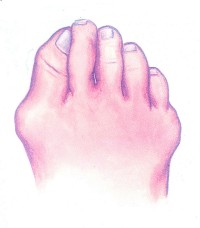
A bunion is a bone deformity caused by an enlargement of the joint at the base and side of the big toe (metatarsophalangeal joint). Bunions form when the toe moves out of place. The enlargement and its protuberance cause friction and pressure as they rub against footwear. Over time, the movement of the big toe angles in toward the other toes, sometimes overlapping a third toe (known as Hallux Valgus). The growing enlargement or protuberance then causes more irritation or inflammation. In some cases, the big toe moves toward the second toe and rotates or twists, which is known as Hallus Abducto Valgus. Bunions can also lead to other toe deformities, such as hammertoe.
Many people with bunions suffer from discomfort and pain from the constant irritation, rubbing, and friction of the enlargement against shoes. The skin over the toe becomes red and tender. Because this joint flexes with every step, the bigger the bunion gets, the more it hurts to walk. Over time, bursitis or arthritis may set in, the skin on the bottom of the foot may become thicker, and everyday walking may become difficult—all contributing to chronic pain.
Wearing shoes that are too tight or high heels with a pointed toe shape is the leading cause of bunions. Bunions are not hereditary, but they do tend to run in families, usually because of a faulty foot structure. Foot injuries, neuromuscular problems, flat feet, and pronated feet can contribute to their formation. It is estimated that bunions occur in 33 percent of the population in Western countries.
Treatment for Bunions
Because they are bone deformities, bunions do not resolve by themselves. The goal for bunion treatment is twofold: first, to relieve the pressure and pain caused by irritations, and second to stop any progressive growth of the enlargement. Commonly used methods for reducing pressure and pain caused by bunions include:.
•Removal of corns and calluses on the foot.
•Changing to carefully fitted footwear designed to accommodate the bunion and not contribute toward its growth.
•Orthotic devices—both over-the-counter and custom made—to help stabilize the joint and place the foot in the correct position for walking and standing.
•Exercises to maintain joint mobility and prevent stiffness or arthritis.
Surgical Treatment
Depending on the size of the enlargement, misalignment of the toe, and pain experienced, and to decrease its growth, generaly conservative treatments are most often recommended and are often adequate to prevent progressive damage from bunions. I prefer the conservative method, and in my 18 years of practise, the clinical outcomes and patient satisfaction with conservative approaches have been very satisfactory in this practise.
In rare cases, when Surgery is recommended, please see your doctor for a referral to an Orthopedic Surgeon. In these cases, bunion surgery, known as a bunionectomy, may be advised to remove/reduce the bunion and realign the toe. Bone surgery has its limitations, so please seek your doctors professional opinion also.
Orthotic insoles are often recommended. Why? Many bunions are a result of a biomechanical dysfunction of the foot, for example overpronation. So when an orthotic that controls overpronation is made, then you have addressed the cause that led to the problem in the first place. This would make you retain activity with less pain and prevent/decrease further deterioration on the joint.
Other modalities we incorporate at the clinic includes Laser therapy for inflammation and pain, Rx meds, Rx medicated creams that we shall advise the Pharmacist to formulate, Ultrasound, FMT. Orthopedic footwear, etc. We shall assess, guide and explain to you your options.